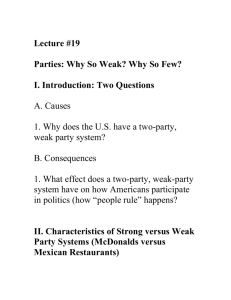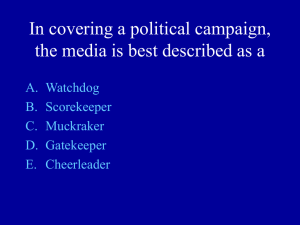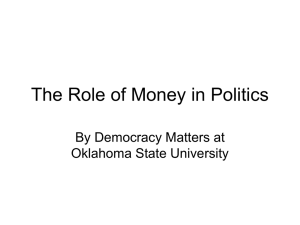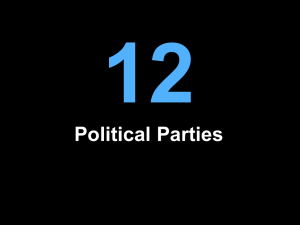Chapter 2 notes
advertisement
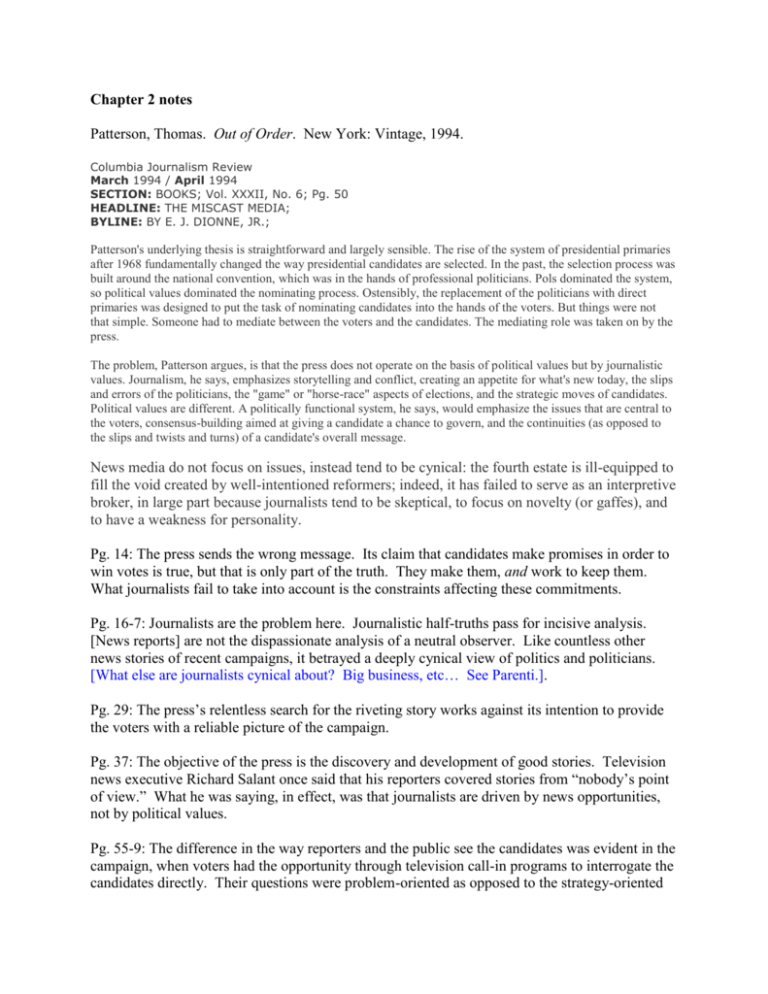
Chapter 2 notes Patterson, Thomas. Out of Order. New York: Vintage, 1994. Columbia Journalism Review March 1994 / April 1994 SECTION: BOOKS; Vol. XXXII, No. 6; Pg. 50 HEADLINE: THE MISCAST MEDIA; BYLINE: BY E. J. DIONNE, JR.; Patterson's underlying thesis is straightforward and largely sensible. The rise of the system of presidential primaries after 1968 fundamentally changed the way presidential candidates are selected. In the past, the selection process was built around the national convention, which was in the hands of professional politicians. Pols dominated the system, so political values dominated the nominating process. Ostensibly, the replacement of the politicians with direct primaries was designed to put the task of nominating candidates into the hands of the voters. But things were not that simple. Someone had to mediate between the voters and the candidates. The mediating role was taken on by the press. The problem, Patterson argues, is that the press does not operate on the basis of political values but by journalistic values. Journalism, he says, emphasizes storytelling and conflict, creating an appetite for what's new today, the slips and errors of the politicians, the "game" or "horse-race" aspects of elections, and the strategic moves of candidates. Political values are different. A politically functional system, he says, would emphasize the issues that are central to the voters, consensus-building aimed at giving a candidate a chance to govern, and the continuities (as opposed to the slips and twists and turns) of a candidate's overall message. News media do not focus on issues, instead tend to be cynical: the fourth estate is ill-equipped to fill the void created by well-intentioned reformers; indeed, it has failed to serve as an interpretive broker, in large part because journalists tend to be skeptical, to focus on novelty (or gaffes), and to have a weakness for personality. Pg. 14: The press sends the wrong message. Its claim that candidates make promises in order to win votes is true, but that is only part of the truth. They make them, and work to keep them. What journalists fail to take into account is the constraints affecting these commitments. Pg. 16-7: Journalists are the problem here. Journalistic half-truths pass for incisive analysis. [News reports] are not the dispassionate analysis of a neutral observer. Like countless other news stories of recent campaigns, it betrayed a deeply cynical view of politics and politicians. [What else are journalists cynical about? Big business, etc… See Parenti.]. Pg. 29: The press’s relentless search for the riveting story works against its intention to provide the voters with a reliable picture of the campaign. Pg. 37: The objective of the press is the discovery and development of good stories. Television news executive Richard Salant once said that his reporters covered stories from “nobody’s point of view.” What he was saying, in effect, was that journalists are driven by news opportunities, not by political values. Pg. 55-9: The difference in the way reporters and the public see the candidates was evident in the campaign, when voters had the opportunity through television call-in programs to interrogate the candidates directly. Their questions were problem-oriented as opposed to the strategy-oriented questions that reporters tend to ask at press conferences. The differences in outlook between reporters and voters reflect what psychologists describe as a difference in schemas. A schema is a cognitive structure that a person uses when processing new information and retrieving old information. It is a mental framework the individual constructs from past experiences that helps make sense of a new situation. Schemas are a way of coping with complexity. Schemas help us understand new information, provide us with a framework within which to organize and store it, enable us to derive added meaning from the new situation by filling in missing information. The dominant schema for the reporter is structured around the notion that politics is a strategic game. The voters possess a different schematic outlook. They view politics primarily as a means to choose leaders and solving their problems. A consequence is that the press’s version of the campaign does not mesh with the voters’ concerns. Pg. 60: The game schema dominates the journalist’s outlook in part because it conforms to the conventions of the news process. The first fact of journalistic life is that the reporter must have a story to tell. The news is not a mirror held up to society. It is a selective rendition of events told in story form. Pg. 74: fig.2, Increase since 1960 in the rise of game versus policy schemas in the news. Pg. 79: National correspondents were celebrities—some more than others, but all were exalted by television’s influence on the public perception of their importance. The Pentagon Papers and Watergate further boosted the reputation of journalists and gave a twist to their relations with politicians. The press responded to the trickery of the Johnson and Nixon administrations with a style of reporting that was decidedly more aggressive. If the politician was going to lie to the journalist, then the latter would scrutinize the former’s every word and action. If before Watergate and Vietnam the game had been a theme of election news, it was now also a theory: candidates did not merely seek to win; they would do anything to win. Journalists had been silent skeptics; they became vocal cynics. This was particularly true among the “elite” national journalists. The game schema was a potent weapon. It offered, within the rules of journalism, a ready means of undermining what candidates were saying. Pg. 80-2: The emergence of this more aggressive style of reporting coincided with and was exaggerated by the impact of commercial television on journalism. Television relies on an interpretative style of reporting that emphasizes the “why” more than the “what.” See figure 2.3 for an increase in the “why” style of reporting. Pg. 89-91: When voters encounter game-centered stories, they behave more like spectators than participants in the election, responding, if at all, to the status of the race, not to what the candidates represent. By altering the way in which the choice was framed, people’s preferences were completely changed. The press’s tendency to frame the election within the schematic structure of the game has an effect of how voters see the campaign. Pg. 93: By emphasizing the game dimension day after day, the press forces it to the forefront, strengthening the voters’ mistrust of the candidates and reducing their sense of involvement. Sabato, Larry J. Feeding Frenzy: Attack Journalism and American Politics. Baltimore: Lanahan, 2000. Pg. 31: While not eclipsing newspapers, television frequently overshadows them. The TV news industry differs from its print cousin in a variety of ways. For one, the number of outlets has been increasing, not declining as with newspapers. The three networks now receive broadcast competition from CNN, C-SPAN, Fox, and PBS.

